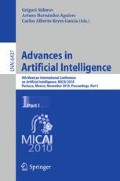Abstract
Word Sense Disambiguation (WSD) is considered one of the most important problems in Natural Language Processing. Even if the problem of WSD is difficult, when we consider its bilingual version, this problem becomes to be much more complex. In this case, it is needed not only to find the correct translation, but this translation must consider the contextual senses of the original sentence (in a source language), in order to find the correct sense (in the target language) of the source word. In this paper we propose a model based on n-grams (3-grams and 5-grams) that significantly outperforms the last results that we presented at the cross-lingual word sense disambiguation task at the SemEval-2 forum. We use a naïve Bayes classifier for determining the probability of a target sense (in a target language) given a sentence which contains the ambiguous word (in a source language). For this purpose, we use a bilingual statistical dictionary, which is calculated with Giza++ by using the EUROPARL parallel corpus, in order to determine the probability of a source word to be translated to a target word (which is assumed to be the correct sense of the source word but in a different language). As we mentioned, the results were compared with those of an international competition, obtaining a good performance.
This work has been partially supported by the CONACYT project #106625, as well as by the PROMEP/103.5/09/4213 grant.
Access this chapter
Tax calculation will be finalised at checkout
Purchases are for personal use only
Preview
Unable to display preview. Download preview PDF.
References
Aguirre, E., Edmonds, P.: Word Sense Disambiguation, Text, Speech and Language Technology. Springer, Heidelberg (2006)
Chan, Y., Ng, H., Chiang, D.: Word sense disambiguation improves statistical machine translation. In: Proceedings of the 45th Annual Meeting of the Association of Computational Linguistics, pp. 33–40 (2007)
Carpuat, M., Wu, D.: Improving statistical machine translation using word sense disambiguation. In: Proceedings of the 2007 Joint Conference on Empirical Methods in Natural Language Processing and Computational Natural Language Learning (EMNLPCoNLL), pp. 61–72 (2007)
Florian, R., Yarowsky, D.: Modeling consensus: Classifier combination for word sense disambiguation. In: Proceedings of the 2002 Conference on Empirical Methods in Natural Language Processing, pp. 25–32 (2002)
Lee, Y.K., Ng, H.T.: An empirical evaluation of knowledge sources and learning algorithms for word sense disambiguation. In: Proceedings of the 2002 Conference on Empirical Methods in Natural Language Processing, pp. 41–48 (2002)
Mihalcea, R.F., Moldovan, D.I.: Pattern learning and active feature selection for word sense disambiguation. In: Proceedings of the Second International Workshop on Evaluating Word Sense Disambiguation Systems (SENSEVAL-2), pp. 127–130 (2001)
Yarowsky, D., Cucerzan, S., Florian, R., Schafer, C., Wicentowski, R.: The johns hopkins senseval2 system descriptions. In: Proceedings of the Second International Workshop on Evaluating Word Sense Disambiguation Systems (SENSEVAL-2), pp. 163–166 (2001)
Ng, H.T., Wang, B., Chan, Y.S.: Exploiting parallel texts for word sense disambiguation: An empirical study. In: Proceedings of the 41st Annual Meeting of the Association for Computational Linguistics, pp. 455–462 (2003)
Alonso, G.B.: Spanish word sense disambiguation with parallel texts (In spanish: Desambiguacion de los sentidos de las palabras en español usando textos paralelos). PhD thesis, Instituto Politécnico Nacional, Centro de Investigación en Computación (2010)
Sinha, R., McCarthy, D., Mihalcea, R.: Semeval-2010 task 2: Cross-lingual lexical substitution. In: Proceedings of the NAACL HLT Workshop on Semantic Evaluations: Recent Achievements and Future Directions, Association for Computational Linguistics, pp. 76–81 (2009)
Harris, Z.: Distributional structure. Word 10(23), 146–162 (1954)
Author information
Authors and Affiliations
Editor information
Editors and Affiliations
Rights and permissions
Copyright information
© 2010 Springer-Verlag Berlin Heidelberg
About this paper
Cite this paper
Vilariño, D., Pinto, D., Tovar, M., Balderas, C., Beltrán, B. (2010). A Probabilistic Model Based on n-Grams for Bilingual Word Sense Disambiguation. In: Sidorov, G., Hernández Aguirre, A., Reyes García, C.A. (eds) Advances in Artificial Intelligence. MICAI 2010. Lecture Notes in Computer Science(), vol 6437. Springer, Berlin, Heidelberg. https://doi.org/10.1007/978-3-642-16761-4_8
Download citation
DOI: https://doi.org/10.1007/978-3-642-16761-4_8
Publisher Name: Springer, Berlin, Heidelberg
Print ISBN: 978-3-642-16760-7
Online ISBN: 978-3-642-16761-4
eBook Packages: Computer ScienceComputer Science (R0)

